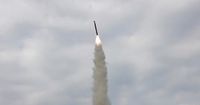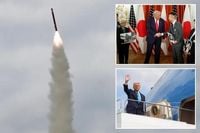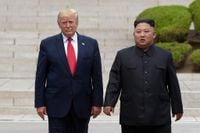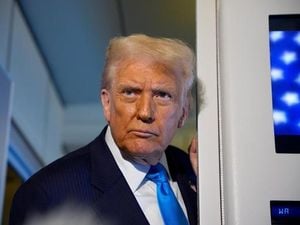North Korea’s military ambitions were on full display this week as the country announced the successful test-firing of several sea-to-surface cruise missiles, just hours before U.S. President Donald Trump arrived in South Korea for a high-profile diplomatic visit. According to the Korean Central News Agency (KCNA), the missiles, launched on Tuesday, October 28, 2025, flew for more than two hours before striking targets in the country’s western waters with precision. The test, which KCNA described as another step in expanding the operational sphere of North Korea’s nuclear-armed military, has drawn the attention of regional powers and the global community alike.
South Korea’s Joint Chiefs of Staff confirmed they had detected North Korean launch preparations earlier in the day, with the cruise missiles fired from northwestern waters at approximately 3 p.m. local time. Both the South Korean and U.S. militaries are now analyzing the weapons, maintaining what officials describe as a combined defense readiness capable of a “dominant response” to any North Korean provocation. As reported by the Associated Press, these tests came hot on the heels of last week’s short-range ballistic missile launches, which North Korea said involved a new hypersonic system designed to strengthen its nuclear deterrent.
Senior North Korean military official Pak Jong Chon, who oversaw the cruise missile tests, lauded the progress in developing the country’s nuclear forces. According to KCNA, Pak stated, “Important successes are being achieved in developing our nuclear forces as a war deterrent.” He emphasized that it was North Korea’s “responsible mission and duty to ceaselessly toughen the nuclear combat posture.” The tests, Pak explained, were aimed at assessing the reliability of various strategic offensive means and making a clear impression of their capabilities on adversaries.
The timing of the tests was no accident. They occurred just hours ahead of a highly anticipated summit between President Trump and South Korean President Lee Jae Myung in the city of Gyeongju, where South Korea is hosting this year’s Asia-Pacific Economic Cooperation (APEC) meetings. Trump’s visit to South Korea is part of a broader Asia tour, which also includes a scheduled summit with Chinese President Xi Jinping. As reported by TNND and Al Jazeera, the North Korean missile launches have cast a shadow over the diplomatic gatherings, raising fresh concerns about the security situation on the Korean Peninsula.
For President Trump, the visit has been marked by both diplomatic outreach and a show of resolve. Speaking with reporters aboard Air Force One as he traveled from Japan to South Korea, Trump appeared to downplay the significance of the North’s missile launches. “He’s been launching missiles for decades, right?” Trump said, referring to North Korean leader Kim Jong Un. Despite the apparent nonchalance, Trump reiterated his desire to meet with Kim during his stay, which would mark their fourth encounter following three meetings in 2018 and 2019. “We had a really good understanding of each other,” Trump told reporters, expressing hope for renewed dialogue.
However, South Korean officials have poured cold water on the prospect of a Trump-Kim summit this time around. As reported by multiple outlets, including the Associated Press and Al Jazeera, officials in Seoul believe a meeting is unlikely, given the current diplomatic freeze. North Korea has shunned talks with both Washington and Seoul since the collapse of high-stakes nuclear diplomacy between Trump and Kim in 2019, during Trump’s first term. The breakdown in negotiations was largely attributed to disagreements over U.S.-led sanctions and North Korea’s nuclear ambitions.
Kim Jong Un’s stance has hardened in recent years. Last month, he reiterated that he would not return to talks with the United States unless Washington abandons its demand for North Korea’s denuclearization—a position that runs counter to longstanding U.S. policy. According to Al Jazeera, Kim has said he still personally holds “fond memories” of Trump but insists that meaningful dialogue can only resume if the U.S. changes its approach. In the meantime, Kim has shifted his foreign policy focus toward strengthening ties with Russia, sending troops and military equipment to support President Vladimir Putin’s war in Ukraine and aligning North Korea as part of a “new Cold War” against the U.S.-led West.
The missile tests themselves were attended by senior officials and included inspections of training exercises aboard North Korea’s newly developed destroyers, Choe Hyon and Kang Kon—assets that Kim Jong Un has described as key to his efforts to strengthen the country’s navy. The display of military hardware is intended not only to enhance North Korea’s war deterrent but also to signal to adversaries that the regime remains undeterred by international pressure.
While in Tokyo prior to his arrival in South Korea, President Trump met with families of Japanese citizens abducted by North Korea decades ago. The meeting, held at the Akasaka State Guest House, was a poignant reminder of the human cost of North Korea’s actions beyond its borders. According to Al Jazeera, Trump assured the families that “the US is with them all the way,” as they pleaded for help in locating their loved ones. North Korea admitted in 2002 to having kidnapped 13 Japanese citizens, five of whom were later repatriated. Japan maintains that 17 of its citizens were abducted, while North Korea claims that some are deceased and others never entered the country.
Back in the region, the missile tests and the broader diplomatic impasse have reignited debates over security, deterrence, and the prospects for peace. Some analysts argue that North Korea’s actions are a calculated attempt to gain leverage ahead of any future negotiations, while others see them as a sign of Pyongyang’s deepening alignment with Russia and China. The United States and South Korea, for their part, continue to emphasize their combined defense posture and readiness to respond to any provocation. As South Korea’s Joint Chiefs of Staff put it, the allies are committed to maintaining a “dominant response” capability—an assurance that resonates with many in the region, even as it leaves the path to dialogue uncertain.
With the world’s attention fixed on the Korean Peninsula, the coming days will test the resolve of all parties involved. Whether the missile tests are a prelude to renewed talks or a further escalation in tensions remains to be seen. For now, North Korea’s message is clear: it will not be ignored, and its military ambitions remain very much alive.






